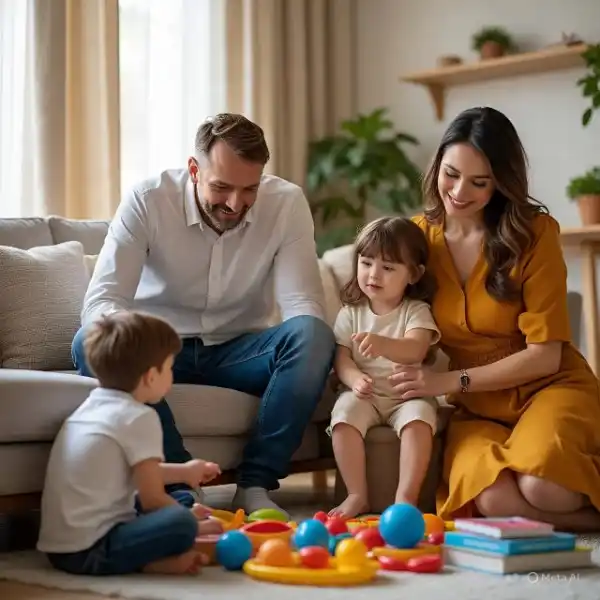Open Adoption Rules: 9 Exclusive Things You Should Know

Are you considering open adoption? That’s nice; however, you must prepare yourself well for this life-changing journey you want to embrace. This is because, as much as open adoption offers the birth parents a great opportunity to maintain a relationship, it also comes with some rules and expectations.
To help you make this journey smoother, I have compiled some essential open adoption rules and guidelines you must follow to the end. These rules will help you to create a clear boundary, maintain good communication, and then make sure the adopted child’s interests are protected.
So, whether you want to navigate the open adoption agreement, create your boundaries, or manage the emotional complexities that come with adoption, these open adoption rules will help you succeed. What you will get in this wonderful guide will reduce time spent on research, so you can focus on building a positive relationship with the birth family.
What Does Open Adoption Mean?
This is the type of adoption where both the adoptive family and the adoptive parent hold their relationship and contact even after the adoption is finalized. Although their relationship can vary.
The type of relationship includes the adoptive family sending picture updates of the adoptee, exchanging letters, or even visiting. The chief aim of this type of relationship between the two is to provide the adopted child with a sense of connection and identity to their birth family.
Although open adoption engenders openness, you must ensure to create boundaries and have effective communication to avoid emotional challenges. To learn more about open adoption, consider reading this post. Understanding the open adoption rules is important, as it will help you understand the extent of interaction to have with each other to be successful.
The Legal and Implications of Open Adoption:
In the legal aspect of an open adoption, there is a need for an open adoption agreement. This is a formal arrangement that shows how the birth family and the adoptive family will communicate.
In some states, these agreements are enforced on both parties to ensure that they follow the terms set during the adoption process.
The emotional part of open adoption is also interesting, as it provides a perfect atmosphere of peace for both parties. The parties are also equipped to answer any question the child will have as the day goes by. However, it requires a perfect commitment to open adoption rules to work out perfectly without stress.
Set clear boundaries and expectations:
Number one on my list of open adoption rules is to set your boundaries and expectations before the adoption. Since you are allowed to share your contacts, it’s important both of you also decide on the level of communication, like when to meet or send pictures.
Having these boundaries on the ground ensures that your relationship remains healthy and free from challenges. Open dialogue about your boundaries from the beginning shields all other conflicts that will come in the future and makes your adoption journey interesting for both you and the child.
Ongoing Communication Commitment: To ensure that the open adoption rules are kept, you must commit to the ongoing communication between you, whether you like it or not.
Whether you send the letter or email by yourself or not, just note that staying connected creates a sense of belonging for the adoptee and peace of mind for the adoptive mom.
However, both of you must agree on the communication style and how to be committed to it. Being committed to all these helps the child to feel loved by both of you and have a sense of identity.
This consistency enables the child to maintain a strong sense of identity while feeling loved by both their adoptive and biological families over time.
Respecting the child’s emotions:
Among the best open adoption rules on my list is having the child’s emotions in mind throughout the process. Always be mindful of how the child feels as regards maintaining a relationship with the birth family. Never for once pressure the child into something they are not comfortable with.
These open adoption rules ensures that the child’s well-being is the primary focus, helping them navigate any complex emotions about their adoption. Respecting their emotional space strengthens trust and stability in the adoptive family dynamic.
4. Honesty and Transparency:
Honesty and transparency are essential to open adoption rules that ensure everyone involved feels secure. Adoptive parents should be open with the child about their adoption story, sharing age-appropriate details as they grow. This openness fosters a healthy relationship with both the adoptive and birth families, preventing confusion or feelings of betrayal in the future.
Transparency also applies to the communication between the families, ensuring that everyone stays informed and respects the child’s need to understand their personal history.
5. Mutual Respect Between Birth and Adoptive Families:
An important open adoption rules is fostering mutual respect between the birth and adoptive families. Both parties need to recognize and appreciate the roles they play in the child’s life. Open adoption thrives when both families collaborate without judgment or competition.
This respect is crucial for maintaining a positive, cooperative relationship, benefiting the child’s emotional development and overall well-being. Honoring each other’s boundaries and contributions sets a solid foundation for ongoing communication and support throughout the child’s life.
6. Flexibility and Adaptability:
Flexibility is one of the core open adoption rules that allows families to adjust the relationship dynamics as the child grows. The needs of the child, birth parents, and adoptive family can change over time, so it’s essential to remain adaptable.
This might involve increasing or decreasing contact depending on what’s best for the child. Flexibility also means being open to renegotiating agreements if circumstances change, such as relocation or significant life events. Adaptability helps preserve harmony and balance in the open adoption relationship.
7. Child-Centered Decision Making:
The most important of all open adoption rules is ensuring all decisions are made with the child’s best interest at heart. Whether determining the level of contact, addressing emotional needs, or setting boundaries, the child should always come first.
This rule fosters a healthy environment where the child feels loved and supported by both their adoptive and birth families. Child-centered decision-making helps everyone involved stay focused on the ultimate goal—raising a confident, emotionally secure child in a loving, stable home.
Legal Considerations in Open Adoption:
Now that you want to go through open adoption, you must have all the legal framework governing the agreement. As I earlier said, open adoption for both of you to maintain a relationship post-adoption, which includes sharing photos and regular communication. However, what is contained in agreements can be different depending on the state laws and other details of the arrangement.
Enforceability Of Open Adoption Agreement:

Note that not all the states enforce this open agreement, but the majority does. Some states. Some states recognize these agreements as legally binding contracts, while others treat them as moral or informal arrangements that are not enforceable in court.
Before any state will enforce the adoption agreement laws, those agreement laws must be included in their adoption laws, and both parties are expected to follow it to the last line.
– The State Specific Laws:
I also tell you that different states have different legal open adoption rules concerning what the adoption agreement will contain. For example, while some states may minimize the level of contact you will share, others may be more flexible in determining the rights of visitation or communication.
Both of you must research to understand the scope of open adoption agreement laws of your state to avoid mistakes.
– Modification To The New Agreement:
In most of the states, the legal open adoption rules allow the open adoption agreement to be modified, especially if the parties are in agreement. Changing some terms, like the frequency of communication or contact, can be modified. In some other states, the court can modify the agreement so it suits the child’s interests.
– Court Involvement:
In some jurisdictions, the open adoption agreement laws must be approved by a court before they become enforceable. This means that the court must review the agreement and make sure that it will favor the adoptee before it becomes binding legally.
The best part is that once approved by the court, it automatically becomes part of the adoption decrees, and everyone is required to follow it. However, only the court has the power to either modify or enforce during challenges.
– The Termination of Parental Rights:
Another important aspect of legal open adoption rules is about how to terminate the birth parent’s right over the child. I know you are surprised when we talk about the termination of parents’ rights here, but just like in other adoptions, birth parents’ rights are also terminated.
The openness of this type of adoption is only about the maintenance of communication and relationships and doesn’t relate to the legal rights of the child’s parents.
– The Child’s Best Interest Standard:
One of the things that matters the most about open adoption agreement laws is the best interest of the child and nothing more. All courts and adoption agencies must prioritize both the child’s emotional needs and psychological well-being as they determine to modify or enforce an open adoption agreement. If it goes contrary, then it will not be enforced or modified.
– NonCompliance:
Every party involved in this adoption journey is expected to comply with the terms of the agreement, such as not withholding communication or not allowing scheduled visits. If anyone fails to comply, the enforcement of the adoption agreement automatically comes into question.
Also, in states where these agreements are legally binding, the party in violation can be taken to court, and a judge may enforce compliance or even modify the terms. However, there may be little legal recourse in the states where these agreements are not enforceable.
Building a Long-Term Relationship in Open Adoption:
Now that you know that open adoption is all about relationships, you should be very ready to build and maintain it over time for the well-being of everyone involved. Open adoption allows you to build continuous interaction with children and their parents.
A foundation that is built with trust and respect will help both of you have a smoother and more complex adoption journey. There are always challenges to face in this journey, but creating this positive relationship over time is required for the child to have a sense of identity and stability.
The Core Importance Of Communication In Open Adoption:
Communication is the most important aspect of an open adoption. Effective communication creates transparency and minimizes the risk of misunderstanding.
Maintain regular contact with each other to make everyone feel secure, and as the child matures, the communication helps them address all their questions about their adoption story. This kind of open dialogue strengthens bonds and reinforces trust, enabling long-term relationship success.
How To Address Challenges in Open Adoption:
As much as open adoption comes with so many benefits, it can be more challenging to maintain this relationship. This is because both of you may experience some emotional complexities or there may be a change of role as time goes on.
That’s why am writing this post—to get you prepared for it. The best is to get your boundaries right from the onset and follow all the open adoption rules I listed for you. Being committed to the terms you agree upon, including the amount of visits and communication, is what makes everybody feel valued and secure.
Why You Need Open Adoption Support:
Support is very important when it comes to open adoption, and I mean support from adoption agencies, legal professionals, counselors, etc. who can advise or provide mediation when necessary.
Both you and the adoptive mom can benefit from these adoption resources in resolving conflicts and navigating emotional challenges. Don’t neglect these services, as it will ensure your relationship becomes stronger and more supportive.
Rounding Up:
There is every need to follow all the open adoption rules to have and maintain a healthy relationship over time.
These set rules will protect everyone’s emotional well-being and ensure the child’s best interests are prioritized. Seeking adoption support, such as legal advice or counseling, is key to navigating challenges and strengthening relationships for the long term.



